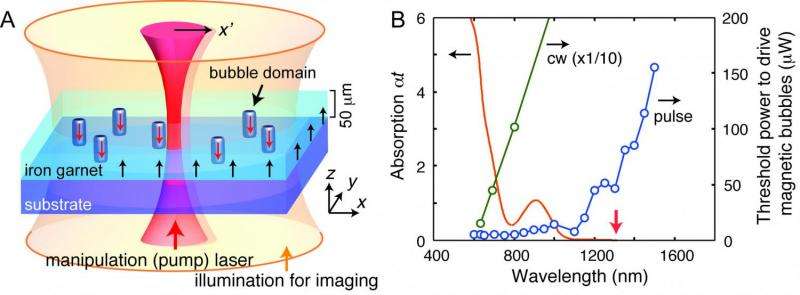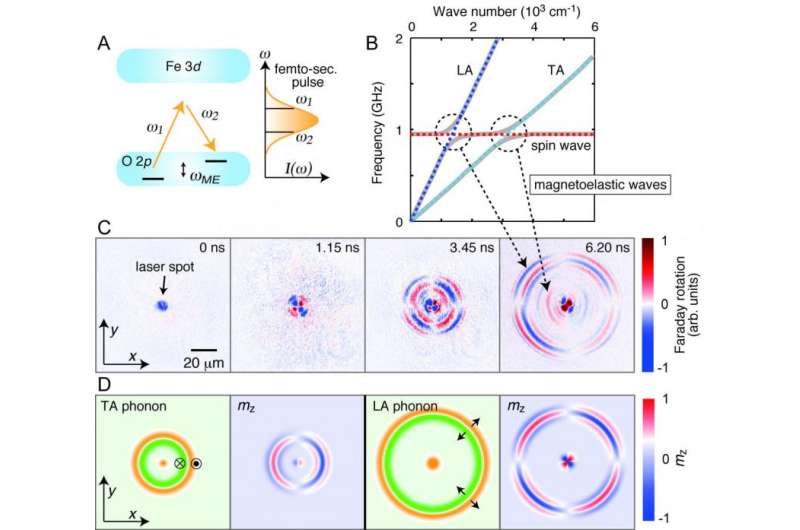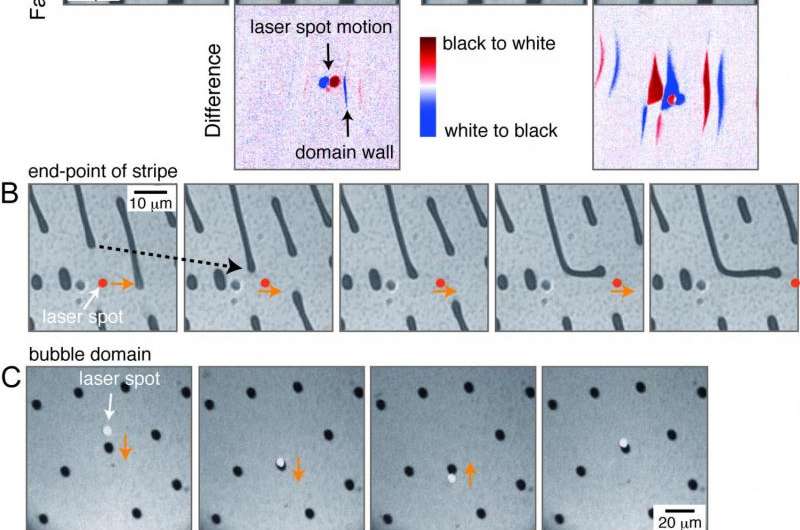August 25, 2015 feature
Magnon, meet phonon: Magnetoelastic waves can drive magnetic bubbles through photoexcitation

(Phys.org)—Research in spintronics (short for spin transport electronics – the study of the electron's intrinsic spin and associated magnetic moment in solid-state devices) continues to be focused on methods for exercising precise control of magnetic domain walls, which are topological solitons (that is, phase defects in the spin alignment separating magnetic domains). Moreover, spin momentum can be delivered to and exchanged with magnetic domain walls using magnons – quantized spin waves – in both metals and insulators.
Recently, scientists at RIKEN Center for Emergent Matter Science, Japan reported that in iron garnet films, magnetoelastic waves (the coupled propagation of magnons and quantized acoustic quasiparticles known as phonons) can drive magnetic bubbles, or curved magnetic domain walls, using non-resonant photoexcitation where phonons are generated by impulsive stimulated Raman scattering (ISRS) – a process in which the incident photon in an ultrafast laser pulse is not absorbed in the material, but nevertheless imparts (or gains) a small amount of energy. (This means that in their experiment, nonabsorbing photon energy was not absorbed by the iron garnet film.) Moreover, they imaged the resulting magnetoelastic waves with time-resolved Faraday microscopy, finding that the resultant spin transfer force was evaluated to be larger for domain walls with steeper curvature. The scientists say that their results demonstrate the capability of rapid spatiotemporal control of magnetic textures in insulating magnets – and that since the magnetoelastic wave is a photon-generated coherent magnon/phonon coupling, it may be possible to devise an interconnection between magnonic, phononic, and photonic circuits.
Dr. Naoki Ogawa discusses the paper that he and his colleagues published in the Proceedings of the National Academy of Sciences, starting with the challenge of demonstrating that magnetoelastic waves can be generated in an iron garnet film by ultrafast laser pulses, and be a source of spin momentum. "Our motivation is to control small magnetic domains, such as skyrmions" (nanometer-scale quasiparticles) "in ultrafast and local manner by laser light," Ogawa tells Phys.org. "It has been known that one can generate spin waves in some magnets by Photoexcitation – but previously, such photo-excited genuine spin waves were too weak to set magnetic domains into motion." While looking for a way to strongly excite spin waves in an iron garnet, the scientists conceived of the idea that a magnetoelastic wave – that is, a spin wave enhanced by a phonon, or sound wave – has the potential to deliver enough force to magnetic domains. (He adds that the concept of magnetoelastic waves was originally introduced almost 60 years ago by C. Kittel1, adding that the creation of magnetoelastic waves by photoexcitation had not been previously reported.)
"By setting up a subpicosecond time-resolved magneto-optical microscope, and by carefully choosing the excitation conditions, we found that magnetoelastic waves can be generated by ultrafast laser pulses. The important issue here is that the light is off resonance, meaning that the light does not strongly couple to the magnetic material because the photon excitation energy is below the absorption edge." This has the significant benefit that while the magnetic material hardly heats up, there is still sufficient energy transfer from the light to excite the magnetoelastic waves.
In addition, this traveling spin wave excitation drives the magnetic domains such that efficiency increases with wall curvature steepness – but the spin-transfer torques on the domain walls exerted by spin waves have been studied primarily for "straight" domain walls. "After succeeding in the generation of magnetoelastic waves, we studied their interaction with various magnetic domain structures by following their motion under a video-rate magneto-optical microscope," Ogawa recounts. "We soon noticed that the interaction depends on the local curvature of the domain wall, which is intuitively consistent with recent studies of magnetic skyrmions, where the local winding of the spin moment leads to giant electromagnetic interactions."
An aspect of the investigation that required great precision was imaging magnetoelastic waves using time-resolved Faraday microscopy. "The time-resolved magneto-optical microscopy itself is a tried-and-tested technique," Ogawa says. "We carefully chose the magnification and time resolution for the expected magnetoelastic waves, and also varied excitation conditions – such as the orientation of the external magnetic field – to show that the observed Faraday rotation patterns are consistent with the analytical expressions of the magnetoelastic waves given by Kittel1." (Faraday rotation refers to interactions between light and a magnetic field in a medium.)

The paper reported that magnetoelastic waves can drive magnetic bubble domains in an iron garnet. After confirming that the magnetoelastic waves can be excited in iron garnet films, the scientists studied the interactions by applying them to magnetic bubbles and other magnetic domain structures. "We found that these domains, or domain walls, were coerced into motion only when the laser excitation is strong enough to generate magnetoelastic waves."
The team also expects that the magnetoelastic waves are generated by the stimulated Raman process, similar to the case of inverse-Faraday effect, because the nonabsorbing pump laser is used for the excitation. "In the field of time-resolved optical spectroscopy, it's well known that one can excite phonons and magnons in solids using various types of optical excitations. Among them, the stimulated Raman process has been a general tool to generate phonons, and is also demonstrated recently to have a strong potential for creating magnons. Therefore, it's reasonable to expect that both phonons and magnons can be excited at the same time, possibly in a hybridized manner." Moreover, Ogawa points out that with this excitation process, they can avoid excess heating of and thermal damage to the magnetic media.
Among other results, the scientists demonstrated the ability to realize a local and coherent source of spin waves without generating excessive heat. "In many spin wave devices, Ørsted fields induced by the flow of electric current in micropatterned electrodes are used to impulsively or resonantly excite spin precessions in adjacent magnetic materials," Ogawa says. (Ørsted fields are named for Hans Christian Ørsted – the scientist who in 1819 discovered that electric currents create magnetic fields.) "Since the electrodes are fixed in space, spin waves are always injected at the limited location. In addition, some Joule loss is inevitable." However, by using a focused light spot and off-resonant wavelengths instead, they researchers showed that they could excite magnetoelastic waves at any location in the sample without generating much heat.
The scientists also observed a transition from spin wave to magnetoelastic wave excitations by increasing excitation intensity, a process which Ogawa acknowledges is not entirely understood at present. "It's the first time that this effect has been observed – but it seems very plausible that the coupling of light to matter and the energy transfer of the light to the magnetoelastic waves involve some non-linear processes."

The paper also discusses how precise control of magnetic domain walls is a central topic in spintronics to boost information technology, logic, and memory applications. "In the 1980s, magnetic bubbles were commercially implemented as memory devices, but their development stagnated not long thereafter," Ogawa recalls. "Next-generation magnetic memories – such as spin-transfer-torque RAM, which has already been commercialized, and racetrack memory" (or domain-wall memory) – "use the spin current-driven motion of magnetic domain walls in metals. Since spin waves also carry spin currents and can be generated in both metals and insulators, they may well lead to new memory technologies."
Several groups worldwide are now targeting magnetic skyrmions for memory applications. Skyrmions are similar to magnetic bubbles, but are much smaller in size, 1-200 nm in diameter. "We utilized the magnetic bubbles in our study for the proof of concept, and to visualize the physics in real space. We will expand our study to smaller magnetic structures, which are better for the practical application."
As to their research plans, the scientists are looking at photocontrol of magnetic skyrmions – topologically-protected vortex spin textures that are much smaller (about 1-200 nm, depending on magnetic interactions in the material), making them suitable for high-density memory applications. "Because skyrmions are topologically protected – meaning that the only way to remove them is to flip all the spins at once – even these small magnetic domains are very stable," Ogawa tells Phys.org. As described in their paper, skyrmion dynamics can be similar to those of magnetic bubbles – that is, the local curvature of its constituent spins is susceptible to momentum transfer from incoming spin waves. "Indeed, it's known that skyrmions can be driven by the spin waves – and we predict that they can even be created by photoexcitation."
Ogawa concludes that in addition to spintronics and magnonics, their study might benefit other areas of research, including phononics, photonics and ultrafast spin solid state spectroscopy.
More information: Photodrive of magnetic bubbles via magnetoelastic waves, Proceedings of the National Academy of Sciences (2015) 112(29):8977-8981, doi:10.1073/pnas.1504064112
Related:
1Interaction of Spin Waves and Ultrasonic Waves in Ferromagnetic Crystals, Physical Review (1958) 110:836, doi:10.1103/PhysRev.110.836
Journal information: Proceedings of the National Academy of Sciences
© 2015 Phys.org



















